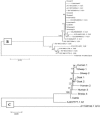Molecular and Morphological Characterizations of Echinococcus granulosus from Human and Animal Isolates in Kashan, Markazi Province, Iran
- PMID: 28761477
- PMCID: PMC5527027
Molecular and Morphological Characterizations of Echinococcus granulosus from Human and Animal Isolates in Kashan, Markazi Province, Iran
Abstract
Background: One of the most important zoonotic helminths in the world is known as Echinococcus granulosus. Different strains of the E. granulosus have been described based on morphological and molecular characterizations, however, there is limited information regarding the characteristics of the phenotypes and genotypes of E. granulosus in Iran.
Methods: The present study was prepared to evaluate the phenotypic and genotypic diversity of E. granulosus isolates collected from human, goat, sheep, and cattle based on 19 standard morphometric parameters and mitochondrial and nuclear genes (CO1, ND1, and ITS1) in Kashan, Markazi Province, Iran during 2013-2014.
Results: The biometric analysis for the 19 characters revealed that the 19 morphometric values of cattle isolates were exceptionally higher than human, goat, and sheep isolates (P<0.05). Molecular analysis confirms the morphological findings. Phylogenic analysis of the CO1, NAD1 and ITS1 genes for all isolates, independent of the host, revealed that the common sheep strain (G1) is traveling among livestock in Kashan and the strains are highly adapted to goats, cattle, sheep, and humans.
Conclusion: Both morphological and molecular results of this study indicated that the only genotype G1 of E. granulosus travels between humans and other intermediate hosts of this parasite in the area study.
Keywords: Echinococcus granulosus; Iran; Molecular phylogenetics; Morphological characterization; PCR-RFLP.
Figures





References
-
- Jawetz M, Adelberg’s Medical Microbiology McGraw-Hill Companies; 2007.
-
- McManus DP, Zhang W, Li J, et al. Echinococcosis. Lancet. 2003; 362( 9392): 1295– 304. - PubMed
-
- Cucher MA, Macchiaroli N, Baldi G, et al. Cystic echinococcosis in South America: systematic review of species and genotypes of Echinococcus granulosus sensu lato in humans and natural domestic hosts. Trop Med Int Health. 2016; 21( 2): 166– 75 - PubMed
-
- Craig PS, Budke CM, Schantz PM, Li T, Qiu J, Yang Y, Zeyhle E, Rogan M, Ito A. Human echinococcosis; a neglected disease? Trop Med Health. 2007; 35: 283– 92.
LinkOut - more resources
Full Text Sources
